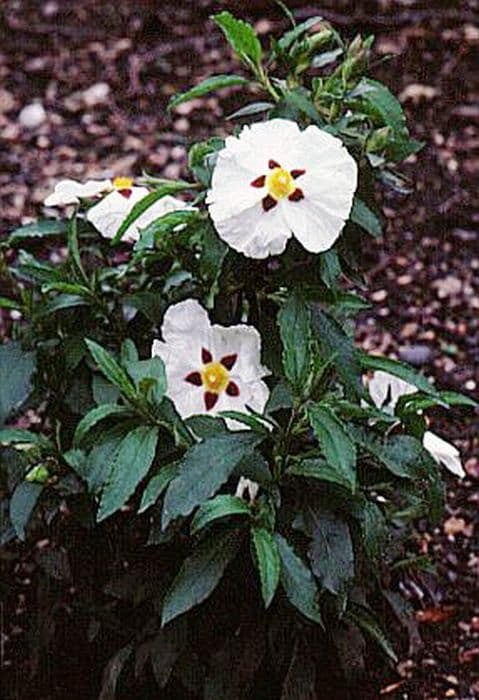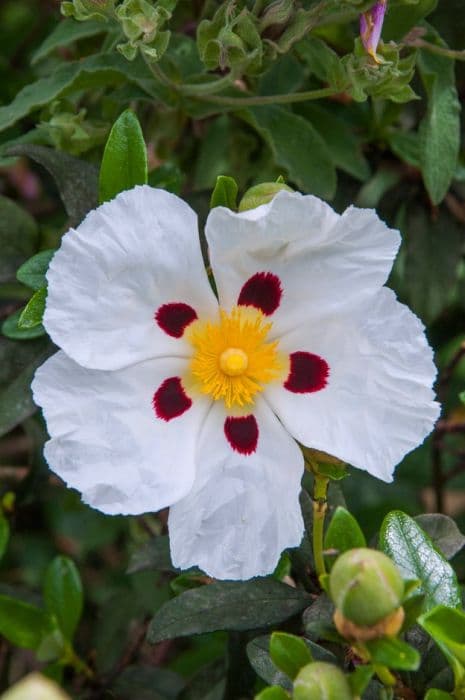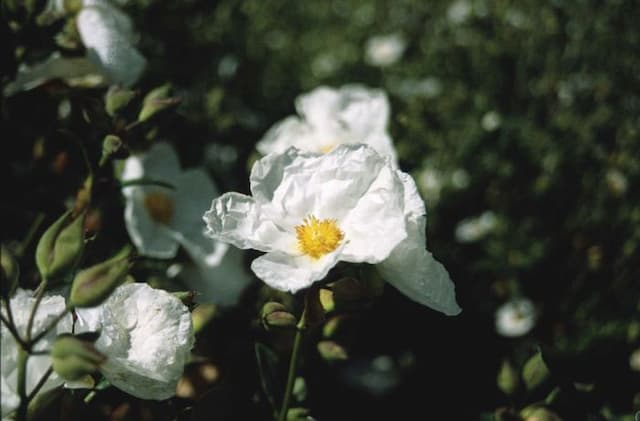Rock rose Cistus × bornetianus 'Jester'

ABOUT
Cistus × bornetianus 'Jester', commonly known as Rock Rose 'Jester', is a decorative evergreen shrub that flaunts a remarkable appearance. This plant is admired for its vibrantly colored flowers which are a significant attraction. The flowers exhibit a striking display with petals that can be described as paper-like in texture, spreading out from the center like delicate crepe. These petals are often painted in shades of pink with a marbled or blotched pattern that gives them a unique appeal. In the heart of each bloom, there's a contrasting set of stamens, typically a golden hue, adding to the exuberant look of the flower. The foliage of Rock Rose 'Jester' adds to its beauty, comprising of small, green leaves which may carry a slightly sticky texture. The leaves are usually lance-shaped or oval, possessing a certain glossy sheen on their surface, contributing to the plant's overall lushness. The stems are woody and may appear somewhat trailing or spreading, giving the plant an attractive, relaxed posture that enhances its ornamental value. The plant's overall aesthetic is one of casual elegance, with a natural, bushy habit that makes it suitable for creating splashes of color in a variety of garden settings. Its appearance carries a Mediterranean charm, reminiscent of the sunny, coastal regions it is often associated with. Despite its delicate-looking flowers, Rock Rose 'Jester' is known for its hardiness and ability to withstand a range of environmental conditions, while still maintaining its enchanting display.
About this plant
 Names
NamesFamily
Cistaceae
Synonyms
Jester Rockrose, Jester Cistus
Common names
Cistus × bornetianus 'Jester'.
 Toxicity
ToxicityTo humans
Rockrose is not commonly listed as a toxic plant to humans. There is limited information on its toxicity, and it does not generally appear on lists of hazardous plants. However, as with ingesting any non-food plant, individual allergic reactions or sensitivities could occur. If you suspect poisoning from any plant, it is advisable to consult a medical professional.
To pets
Rockrose is not commonly known to be toxic to pets such as dogs and cats. However, the lack of specific information means that caution should be exercised. If you notice any unusual symptoms in your pet after ingestion of the plant, such as vomiting, diarrhea, or signs of distress, contact your veterinarian.
 Characteristics
CharacteristicsLife cycle
Perennials
Foliage type
Evergreen
Color of leaves
Green
Flower color
Pink
Height
3 feet (0.91 meters)
Spread
5 feet (1.52 meters)
Plant type
Shrub
Hardiness zones
8
Native area
Mediterranean
Benefits
 General Benefits
General Benefits- **Ornamental Value:** Cistus × bornetianus 'Jester', commonly known as Rock Rose 'Jester', has vibrant, multi-colored foliage and bright pink flowers that add aesthetic appeal to gardens and landscapes.
- **Drought Tolerance:** Rock Rose 'Jester' is extremely drought-resistant, making it ideal for water-wise gardens and regions with dry climates.
- **Low Maintenance:** This plant requires minimal upkeep once established, with little need for watering, fertilizing, or pruning.
- **Attracts Pollinators:** The flowers of Rock Rose 'Jester' attract bees and butterflies, which are beneficial for pollination of garden plants and the local ecosystem.
- **Rapid Growth:** Rock Rose 'Jester' grows quickly, providing fast coverage in garden beds or as ground cover.
- **Heat Resistance:** It can thrive in hot temperatures, making it suitable for warm climates and sunny garden spots.
- **Soil Adaptability:** The plant is adaptable to a wide range of soil types, although it prefers well-drained soils.
- **Deer Resistance:** Rock Rose 'Jester' is not a preferred food source for deer, reducing the likelihood of damage in areas with deer populations.
- **Erosion Control:** Its root system helps stabilize the soil, making Rock Rose 'Jester' useful for controlling erosion on slopes and banks.
- **Long Blooming Season:** The plant typically enjoys a long flowering period, offering color and interest throughout much of the spring and summer.
 Medical Properties
Medical PropertiesThis plant is not used for medical purposes.
 Air-purifying Qualities
Air-purifying QualitiesThis plant is not specifically known for air purifying qualities.
 Other Uses
Other Uses- Cistus 'Jester', or Rockrose, can be used as a natural dye source, with the flowers providing a range of colors for textiles depending on the mordant used.
- The leaves of Rockrose can be infused into oils to create natural fragrances for homemade perfumes or scented candles, appreciated for their warm, amber-like scent.
- Rockrose petals can serve as an edible decoration for salads and desserts, offering a subtle flavor and an attractive addition to gourmet dishes.
- They can be used in potpourri mixtures, contributing their pleasant fragrance as well as a splash of color to a blend of dried flowers and spices.
- The robust, low-maintenance nature of Rockrose makes it suitable for erosion control on slopes or areas prone to soil degradation.
- Due to its thick and bushy growth, it can be planted as a natural barrier to reduce noise pollution in residential gardens.
- Rockrose can be used as a companion plant in permaculture gardens, helping to provide shelter for beneficial insects and pollinators.
- The wood of Cistus 'Jester' is suitable for crafting decorative items or for use as kindling in fireplaces due to its dry and brittle nature.
- Its visually appealing habit makes it an excellent candidate for bonsai creation for enthusiasts looking for Mediterranean plant varieties.
- The plant can play a role in sensory gardens, being tactile with its sticky leaves and aromatic, contributing to a multi-sensory experience.
Interesting Facts
 Feng Shui
Feng ShuiThe Cistus plant is not used in Feng Shui practice.
 Zodiac Sign Compitability
Zodiac Sign CompitabilityThe Cistus plant is not used in astrology practice.
 Plant Symbolism
Plant Symbolism- Resilience: Cistus × bornetianus 'Jester', often referred to as Rock Rose, is known for its ability to thrive in dry and challenging environments, symbolizing the strength and resilience to overcome adversity.
- Beauty: With its colorful and showy flowers, the Rock Rose represents the beauty and aesthetic pleasure found in nature, reminding us to appreciate the simple, visual delights in the world.
- Healing: Historically, the Rock Rose has been used for its medicinal properties, symbolizing healing and the restoration of health. It encourages support and care for oneself and others.
- Survival: Adapted to survive wildfires due to its seed's ability to germinate after fire, the Rock Rose symbolizes rebirth and the ability to emerge stronger from life's trials.
- Protection: In some cultures, Rock Rose is believed to offer protection against evil and to provide a sense of safety, making it a symbol of shelter and security.
 Water
WaterRockrose 'Jester' should be watered deeply but infrequently, allowing the soil to dry out between waterings. Generally, this means watering approximately once every week or two, depending on the weather and soil drainage. During hot or dry periods, increase watering to once a week, providing about 1 to 1.5 gallons of water for each plant. In cooler or rainy periods, reduce watering accordingly. Over-watering can lead to root rot, so ensure good drainage and avoid letting the plant sit in waterlogged soil.
 Light
LightRockrose 'Jester' thrives best in full sun exposure. It should be planted in a location where it receives at least six hours of direct sunlight each day. The intense light and warmth of the sun encourage better blooms and a healthier plant.
 Temperature
TemperatureRockrose 'Jester' is comfortable in a wide range of temperatures, as long as they are not extreme. It can typically handle temperatures as low as 20 degrees Fahrenheit and as high as 100 degrees Fahrenheit. The ideal temperature range for promoting growth and flowering is between 60 to 80 degrees Fahrenheit.
 Pruning
PruningRockrose 'Jester' should be pruned to maintain shape and encourage denser growth. The best time to prune is after flowering in late spring or early summer. Lightly trim back the plant by a few inches each year to keep it tidy and promote new growth.
 Cleaning
CleaningAs needed
 Soil
SoilRock Rose 'Jester' thrives in well-draining soil with a mix of sand, loam, and peat for aeration and moisture retention. A slightly acidic to neutral pH of 6.0 to 7.5 is ideal for this plant.
 Repotting
RepottingRock Rose 'Jester' doesn't require frequent repotting and can be done every 2-3 years or when it outgrows its current container.
 Humidity & Misting
Humidity & MistingRock Rose 'Jester' is tolerant of a wide range of humidity levels but prefers moderate conditions, avoiding excessively dry or humid environments.
 Suitable locations
Suitable locationsIndoor
Place in bright light and avoid overwatering.
Outdoor
Full sun, protect from extreme cold, well-draining soil.
Hardiness zone
8-11 USDA
 Life cycle
Life cycleCistus × bornetianus 'Jester', commonly known as the Jester Cistus, begins its life cycle when seeds germinate, typically in spring with warmth and moisture, although for many hybrids, propagation is more successful via cuttings. After germination, the seedling grows rapidly, developing into a small shrub with a characteristic bushy form. Over late spring to summer, it enters its flowering stage, where it produces its distinctive pink and purple flowers which attract pollinators. After pollination, if conditions allow, the plant may produce small capsules containing seeds that will be dispersed by wind or wildlife. Throughout its life, the Jester Cistus undergoes seasonal cycles of growth in spring and summer, followed by dormancy in winter where growth slows down. This evergreen shrub can live for many years with the right conditions and care, though it may have a shorter life span compared to other garden shrubs, often requiring replanting after several years to maintain vigor.
 Propogation
PropogationPropogation time
Spring-Early Summer
Cistus × bornetianus 'Jester', commonly known as Rock Rose 'Jester', is most commonly propagated through semi-hardwood cuttings. The best time to take cuttings is during the late summer months. To do so, a gardener would select a healthy stem that is not flowering, and cut a 4 to 6-inch (10 to 15 cm) length, making sure that it includes several leaf nodes. The lower leaves are then stripped and the cut end dipped into rooting hormone powder to encourage root development. The cutting is then planted in a well-draining potting mix, lightly watered, and placed under a propagation dome or in a humid, shaded location to retain moisture. It generally takes a few weeks for the cutting to root, after which it can be gradually acclimated to more direct sunlight and eventually planted out into the garden.









